Zhengyangmen, known as Qianmen Gate, Gate Tower of Qianmen, or Daqianmen, was formerly named the Lizheng Gate. It served as the south gate of the Inner City of Beijing in the Ming and Qing Dynasties. Zhengyangmen is located in the southernmost end of the Tiananmen Square in the south-north axis of Beijing and the south of the Memorial Hall of Chairman Mao. Originally built in the 17th year of Emperor Yongle's reign (1419 AD) of the Ming Dynasty, it is one of the "Nine Gates of the Inner City". Consisting of the Gate Tower, the Archery Tower, and the Barbican, it was a complete defensive building system in ancient times.
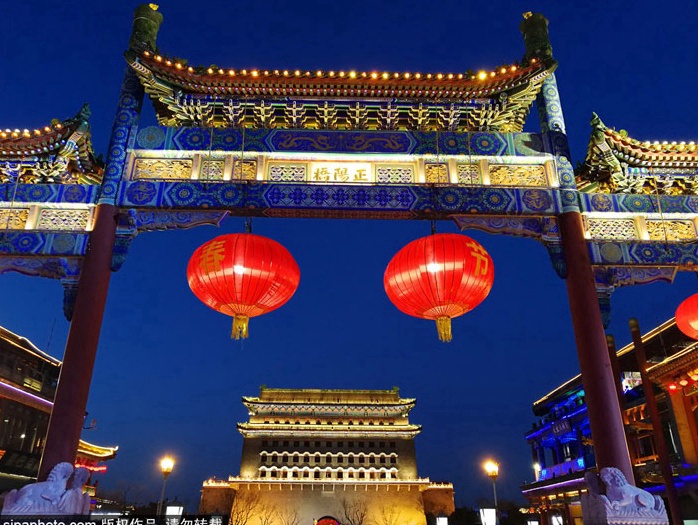
According to the local chronicles, the Gate Tower and the Archery Tower were grand and lofty; the imposing Barbican is a model of city wall buildings in Beijing. Now only the Gate Tower and the Archery Tower are in existence. In the Gate Tower stands the Beijing Folklore Museum.
Zhengyangmen, formerly named Lizheng Gate, was connected as a whole by walls of the Barbican but later separated into two parts due to road repairing. In general, however, Dashilan is also called Qianmen which covers Zhengyangmen as well as Zhubaoshi and Dashilan in its front, and the Gate Tower and the Archery Tower are collectively called Zhengyangmen. It is situated in the south-north axis of Beijing. The Archery Tower, the Gate Tower, the Barbican, Zhengyang Bridge, and the Wupailou Archway constitute an architectural complex with a reasonable layout, a grand structure, and a dignified style.
Zhengyangmen is superior to the other eight gates of the Inner City. They are known as "four gates, three bridges, and the Wupailou Archway". The "four gates" refer to the four gateways of Zhengyangmen, i.e. the gateway to the Gate Tower, the gateway to the Archery Tower, and two gateways to the east and west gates of the Barbican. The other eight gates of the Inner City, however, have only two gateways respectively, i.e. the gateway to the Gate Tower and the gateway to the gate on the one side of the Barbican. There aren't gateways to the Archery Tower. Therefore, these gates only serve as defensive fortresses.
The "three bridges" refer to the Zhengyang Bridge over the city moat in front of the Archery Tower. The bridge is a stone arch bridge, but the broad bridge floor is divided into three passages by handrails. The middle passage facing the gateway to the Archery Tower was known as the royal passage which could only be used by emperors.

The "the Wupailou Archway" refers to the "six-column-and-five-gate" archway crossing streets. In the Ming Dynasty, all the nine gates of the Inner City had archways. Among them, the archway of Zhengyangmen with five gates was superior to the other archways. What's more, only the archway of Zhengyangmen has been rebuilt.
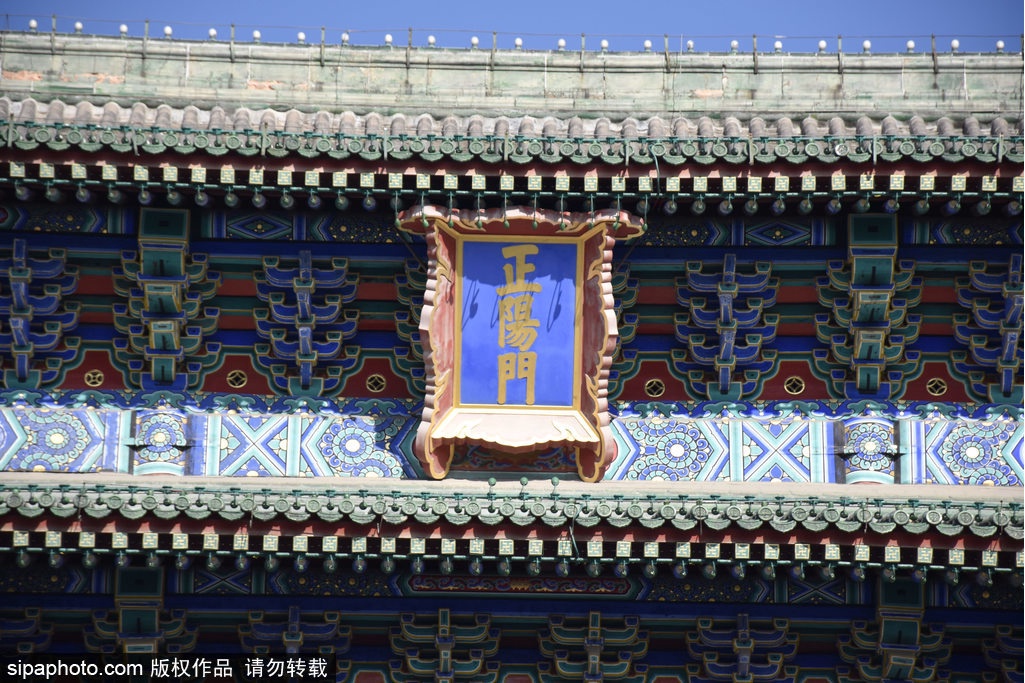
Recommended scenic spots:
Gate Tower of Zhengyangmen
The Gate Tower of Zhengyangmen sits on a brick platform with an obvious volumetric shrinkage from the bottom to the top. The platform has a width of 95 meters, a thickness of 31.45 meters, and a height of 14.7 meters. It has a 1.2-meter-high parapet on the north and south and covers an area of 3,047 square meters. The floor of the platform is paved with city wall bricks. The Gate Tower is a pavilion-style building trimmed with gray pantiles and green glazed tiles in the three-eave and Xieshan (gable and hip roof) style. The ridge is decorated with dragon head decorations, and each side has columns in three stories, i.e. eave columns, old eave columns, and hypostyle columns. The beams and columns are vermilion and painted with colored flower patterns. There are doors in the four sides both in the upstairs and downstairs. The Gate Tower has a length of seven jian (one jian is the distance between two girders) and a width of three jian.
There is a winding corridor between the two floors. The upper floor is installed with doors and windows with rhombic patterns in the front and back, and the lower floor has vermilion brick walls. And there are solid doors in front of the central bay and two sides. Sloping riding tracks are along the inner side of the city wall at the two ends of the Gate Tower to ascend and descend. The Gate Tower has a width of 41 meters and a length of 21 meters; the building body has a width of 36.7 meters, a depth of 16.5 meters and a height of 27.3 meters; the whole Gate Tower is 43.65 meters high, which makes it the highest among all gate towers in Beijing. A large wooden plaque is hung over the eaves in the outer side of the Gate Tower. The arched gateway is set in the center of the platform, with five layers and five vaults. The inner vault is 9.49 meters high and 7.08 meters wide, and the outer vault is 6.29 meters high and 6 meters wide.
Archery Tower
The Archery Tower of Zhengyangmen is a brick fortress building which can best reflect the military defense concept and the workmanship of the ancient times. It stands on a brick platform. The platform is about 12 meters high, with an obvious volumetric shrinkage from the bottom to the top. An arched gate, with five layers and five vaults, is set in the center of the platform, opposite to the city gate. Inside the gateway is an "orgue". The platform is 10 meters wide in the south and 12.4 meters wide in the north. It covers an area of 2,147 square meters. The Archery Tower has four floors. The top was trimmed with gray pantiles and green glazed tiles in the double-eave and Xieshan style and decorated with green glazed animals. A total of 86 arrow holes were dug in the south, east and west for the purpose of defense (to shoot an arrow).
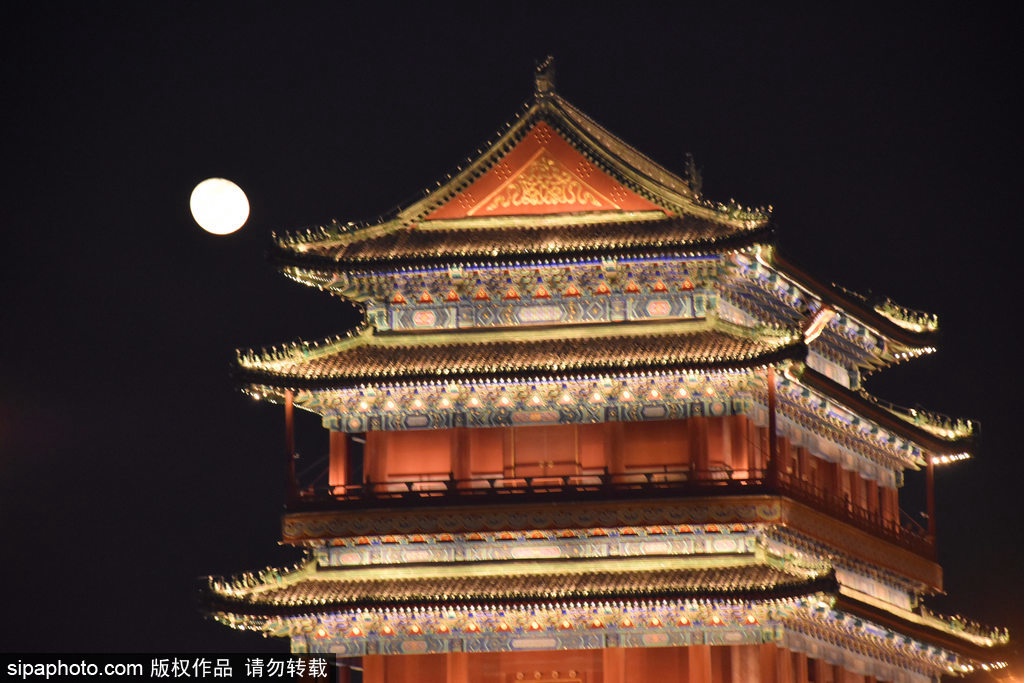
In the south, there are four floors, each with 13 holes; in the east and west, there are also four floors, each with four holes; in the small house attached, there are two holes. The Archery Tower, with a structure of the front tower and rear attached house, has a length of seven jian with a width of 62 meters and a breadth of 20 meters; the five-jian attached house and wing-rooms are in the north, with a width of 42 meters and breadth of 12 meters; and the whole building is 35.37 meters high. Among the archery towers of Beijing in the Ming and Qing Dynasties, only the Archery Tower of Zhengyangmen has a gate and is the loftiest and most majestic one. With a unique structure, it has been regarded as a symbol of old Beijing.
Barbican
Between the Archery Tower and the Gate Tower is an oblong Barbican. It is 108 meters long from south to north and 88.65 meters wide from east to west. The two inner angles in the northeast and northwest are right-angled, and the two outer angles in the southeast and southwest are rounded. The Barbican connects the city wall, the Gate Tower, the Archery Tower and two side towers. The wall of the Barbican is as high as the city wall (about 11.36 meters) but narrower. It has an earth core and is laid with large city wall bricks on the surface. The paved path at the top of the wall was built with city wall bricks. A battlement was built on the outer side of the wall, and a parapet was built on the inner side. There were spaces inside. An arched gateway is dug on the four sides of Barbican, with a lifting gate equipped in the east, west and south. The north gate is under the magnificent Gate Tower, the south gate under the lofty Archery Tower, and the east and west gates under the side towers.
Inside the Barbican, a Temple of Guan Yu and a Goddess of Mercy Temple stand on the two sides near the north gate in the south side of the Gate Tower, the former in the west and the latter in the east. Facing the south, the two one-floor temples, with side rooms and side corridors, are not large. However, there is an endless stream of pilgrims. In the Ming and Qing Dynasties, temples were built in all the Barbicans of the nine gate towers in the Inner City of Beijing as a tradition. Among the nine gates, Emperor Zhenwu was worshiped in the Desheng Gate and the Anding Gate, and Guan Yu was worshiped in the rest gates to guard the state and bless the people. The Temple of Guan Yu in Zhengyangmen, is the largest among others. Legend has it that the statue of Guan Yu was worshiped in the imperial palace of the Ming Dynasty, so there was an endless stream of pilgrims in the Temple of Guan Yu in Zhengyangmen. During the Ming and Qing Dynasties, a lot of inscriptions, poems and essays about consecration and chronicles were left in the Temple of Guan Yu and Goddess of Mercy Temple. They are valuable stone inscriptions for the study of the history of city wall construction and the social and cultural history of Beijing.
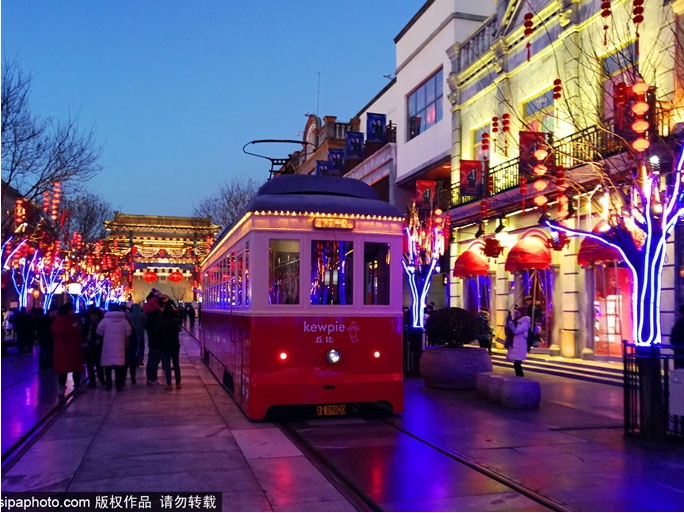
Battlement and parapet
Battlements and parapets are the outer and inner low walls built along the top of city walls. Located at the outer side at the top of city walls and shaped as dentation, battlements serve as shields to protect guards of the city against attacks of invaders. The parapet, aka "parapet wall", refers to the inner low wall built along the top of city walls. It is used to protect guards of the city from falling down. The battlement of the Inner City of Beijing is 1.9 meters high, 1.5 meters wide and 0.75 meters thick, with an interval of about 0.5-0.8 meters. The outer battlement is 1.3 meters high, about 1.2 meters wide and 0.5 meters thick, with an interval of about 0.5 meters. The battlement in the Inner City and the Outer City totals 20,772. A battlement was built with mortar and large city wall bricks. It has a flat top and right angles in four sides and is quite firm. The parapet, about 1.2 meters high and about 0.75 meters thick, was built along the city wall with mortar and large city wall bricks, with a semicircular top on the top. Like the other eight gates of the Inner City, Zhengyangmen was built with battlements in the outer side and parapets in the inner side of the platform, with the same specifications as those of the city walls.
Riding track
The riding track was designed for the guarders of the city so that they could ascend and descend. It was attached against the inner side of the city wall with a gradient from fifteen to thirty and width from four to five meters. On the outer side of the sloping track, a low wall was built.
There are 27 pairs of sloping riding tracks in the Inner City in total, each in the inverted V-shape or V-shape. Either the left or right riding track leads to the top of the Gate Tower. Two sloping riding tracks were built for Zhengyangmen. They were against the inner side of the city wall inside the Barbican, leading to the Gate Tower and the Archery Tower respectively (now in ruins). The construction method is as below: tamp the earth core of the sloping riding track and that of the city wall so that they make a whole, and lay a one-meter-thick brick course with mortar and large city wall bricks as the outer brick course of the sloping track; on the outer brick course, build a low wall parallel to the slope. The low wall is as long as the slope, about 0.75 meters wide and about 1.2 meters high, called the handrail wall of the sloping riding track. The earth core of the sloping riding track was tamped with loess first, later added with a layer of lime-sand-clay mixture about 50 centimeters, and finally with a layer of large city wall bricks, which then became the "gravel" surface of the sloping riding track.
Qianmen Street
Qianmen Street is Beijing’s well-known commercial street. It is located on the central axis of urban Beijing, spanning from the northern Qianmen Yueliangwan to the southern road junction of Tianqiao, connecting with Tianqiao South Street. Before the establishment of Outer City in the 29th year of Emperor Jiajing's reign of the Ming Dynasty (1550 AD), it was the imperial road for emperors to the Temple of Heaven and Altar of Mountains and Rivers; later it became the main north-south street of Outer City. It is called Qianmen Street by the common people. The street is 845 meters long, with a 20-meter-wide roadway. It was called Zhengyangmen Street in the Ming and Qing Dynasties, and the Republic of China. In 1965, the official name “Qianmen Street” was set.

In the early 1950s, there were more than 800 private businesses in the Qianmen area. In the east of Qianmen Street, Dabei Photo, Qing Lin Chun (Qianmen Street), Tong San Yi (fruits and seafood store), Lili Restaurant, Tian Cheng Zhai (dessert store), Bian Yi Fang Roast Duck, Lao Zheng Xing Restaurant, Pride (laundering and dyeing store), Yi Zhao (cotton department store) and Qianmen Hardware Store stand from north to south; in the west, there are Yue Sheng Zhai (selling braised pork with soy sauce), Hua Fu (watch and clock store), Qing Yi Tang (pharmacy), Yi Tiao Long (mutton restaurant), Sheng Xi Fu (hat store), Gong Xing (stationery store), Xiang Ju Gong (dessert store), Long Shun Cheng (carpentry store), Qianmen Dajie Hemp Rope Store, Qianmen Bicycle Store and Qianmen Trust Shop from north to south. After 1979, new stores for hardware and electrical equipment, clothing and general merchandise, bicycles, food, clocks and watches as well as chemical products and paints were successively opened while the time-honored shops and traditional business characteristics were maintained.
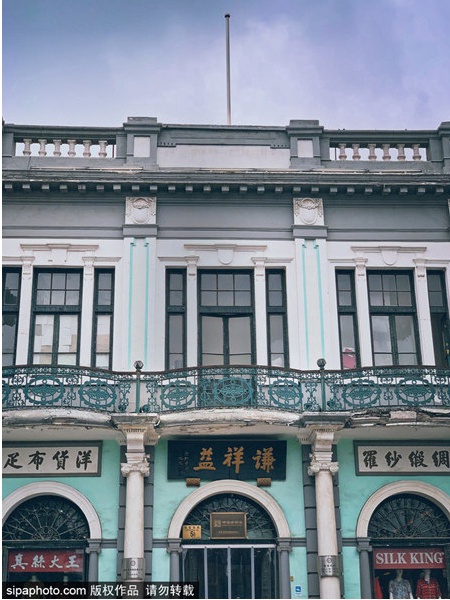
With a long history, Qianmen Street is home to China’s 16 time-honored brands, such as Liu Bi Ju (sauce and pickle shop), Tong Ren Tang (pharmacy), Refosian (silk store), Chang Chun Tang (pharmacy), Nei Lian Sheng (shoe store), Zhang Yiyuan Tea House, Yue Sheng Zhai and Du Yi Chu (shaomai store). In hutongs such as Xianyukou and Damochang, shops and restaurants also stand in great numbers. However, there are no famous time-honored brands; instead, foreigners run shabby beauty salons and small restaurants here. When the reporter arrived at noon, there were one or two guys standing in front of each restaurant to attract pedestrians with their sounds rising one after another.
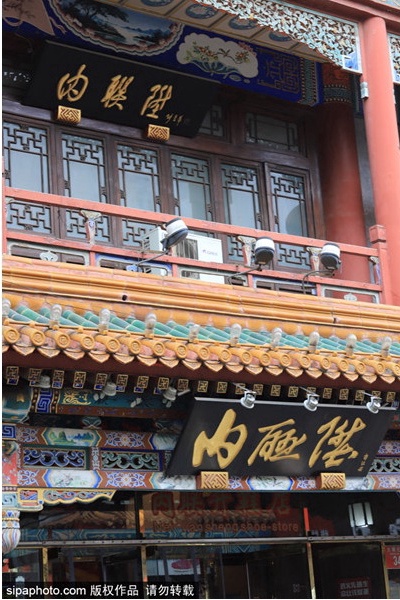
Ten time-honored brands: Quanjude Roast Duck Restaurant, Du Yi Chu, Yue Sheng Zhai, Cathay Bookshop, Yi Tiao Long, Zhang Yiyuan Tea House, Qing Lin Chun Tea Shop, Chang Chun Tang, Yi Zhao (department store), and Da Bei Photo.
Transportation
Route: Taking Line 2 to Qianmen Station, or taking Bus 2, 5, 8, 9, 17, 20, 22, 44, 48, 59, 66, 67, 69, 71, 82, 93, 120, 126, 608, 622, and 623, Express Bus 1, T4, T7 or T11, Night 2, Night 17 or Night 18, Special 2, or Tour Bus Line 1.



